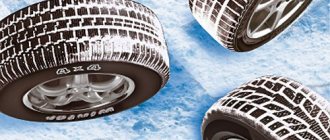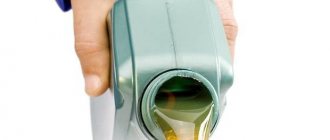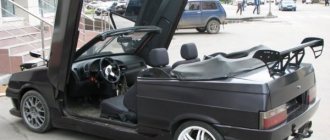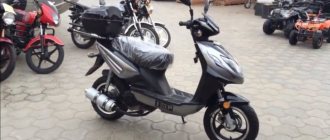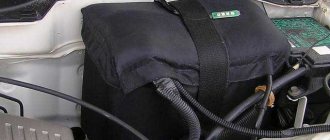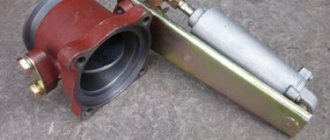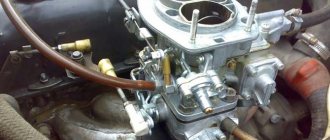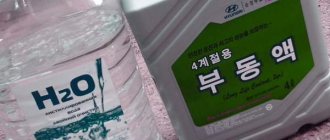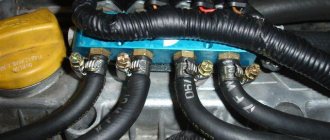The Buran A snowmobile, as well as its modified version Buran AE, are the basic models in the Buran line, built on a shortened frame. This snowmobile is one of the best machines produced by the manufacturer Russian Mechanics OJSC. The main qualities of this vehicle are not only impeccable maneuverability, but also the ability to tow fairly large loads, operate at very low ambient temperatures, and the ability to transport people over certain distances. It is also worth noting that the car is completely unpretentious, both to weather conditions and to the quality of the fuel being poured. All this allowed the snowmobile to gain truly enormous popularity among fishermen and hunters.
In general, all models of the Buran snowmobile have a unique design, namely one support ski and two rear tracks. This solution has already been time-tested many times. Thanks to this, the car is not afraid of stumps, snags, bushes and tree branches that can cause damage to the chassis. The use of exactly two tracks had a positive effect on the vehicle’s cross-country ability, since their total area provides a fairly low specific pressure, which, in turn, makes the Buran A/AE snowmobile a real snow all-terrain vehicle. But also another key point in almost all snowmobiles is maneuverability. With this, everything is going just fine with this machine, since one swivel ski, combined with a fairly short longitudinal base of the equipment, allows you to maneuver in rather cramped conditions, for example, to go around trees in forest areas.
The modernized frame, which received a front bevel in the tunnel, coupled with increased ground clearance, allows you to easily move through deep snow, and, if necessary, easily remove snow clogging the rollers.
Video
At the very beginning, the Buran snowmobile was created as a workhorse and therefore the manufacturer placed great emphasis on the ability to tow loads. This task, one might say, is an everyday one, which the snowmobile copes with simply flawlessly. A large traction force was achieved thanks to the large final drive ratio in the gearbox, the use of an Alpina model variator and a power plant with a fairly large maximum torque. It is worth noting that the engine develops maximum torque at low speeds, which allows you to drag a load weighing no more than 250 kilograms without any difficulty. Of course, this limitation was set only by the manufacturer, because a long operating time often shows that the machine is capable of more.
As was written earlier, there are two versions of the snowmobile, namely Buran A and Buran AE. Externally, both cars are completely identical, but the model with the letter E has an electric starter. The letter A means that the snowmobile has a short platform.
Compared to previous models of this snowmobile, Buran A/AE has a new modern design. The manufacturer has made some changes to the appearance of the hood, as well as to its mounting scheme, which, when tilted, provides full access to all the necessary components and assemblies of the engine. The hood itself is made of injection molded plastic, which is highly resistant to various external influences, impacts and has fairly high strength even at very low temperatures. The level of comfort has also been increased by installing a new high two-level seat on the Buran, which has a removable backrest for the passenger.
And finally, it should be emphasized that this snowmobile is very simple and unpretentious in further maintenance. Spare parts for it are very easy to find, and they are also quite affordable. The machine has excellent maintainability even in field conditions far from civilization.
Which engine to put on a Buran
Description image
Let's consider the advantages of the Lifan engine for the Buran 2V78F-2A snowmobile, which the manufacturer of these motors relies on:
1. Fuel economy is 1.5-2 times thanks to the 4-stroke cycle.
- Let's do the math. In fact, personally tested fuel consumption on 2-stroke engines for Buran is 25-40 l/100 km, for Taiga (1 carb) from 30 to 45 l/100 km. And gasoline consumption depends on many conditions (wet or dry snow, ice or slush, whether you’re traveling alone or seven, driving speed). Then, according to unverified data from the manufacturer, it ranges from 15-22 l/100km to 22.5-34 l/100km. It is unknown whether all operating conditions are taken into account when declaring such a difference in fuel consumption. But we kind of believe it! In total, we get the following ruble result: virtually on average we save 400 rubles per 100 km of travel for a Buran snowmobile with a Lifan engine. Considering the fact that snowmobilers and hunters travel an average of 1,500 km per season, the savings on fuel will be 6,000 rubles. It's nice to save money, but let's move on!
2.Higher speed under load.
- To be honest, it is difficult to imagine high speed on a low-speed 4-stroke engine. Buran is sure to go faster! Yes, and if you install this four-stroke engine 35 hp. to Taiga, as one of the clients suggested, instead of the original two-stroke engine of 43 hp. — don’t go to a fortune teller; the engine’s speed is inferior to Taigovsky’s. And if you drive the Taiga at the same “snail” speed as the Lifan 35 engine at maximum speed, then the fuel consumption will be commensurate with the efficiency of this four-stroke engine, which no longer has such a speed reserve as the Taiga. Hence the conclusion that the Lifan 35 has no fuel efficiency if you “vomit” in the Taiga at the same speed.
3.Better acceleration dynamics due to higher torque.
- Well, maybe so. But who needs this overclocking? Are you going to the race?!)))
4.Saving oil, which does not need to be mixed with fuel.
- Of course, this is a good plus! If we do not consider the fact that Russian Mechanics also has 4-stroke engines from the factory.
5. Cleaner exhaust due to the absence of oil in gasoline and complete combustion of the fuel mixture.
6.Easy starting due to the absence of oil in the fuel and a more advanced carburetor.
- The perfect carburetor? How is this? The most advanced starting is for injection engines. A dubious plus.
- I agree, if you comply with the conditions of the representative of the manufacturer of these motors. And in the warnings he states: “Do not allow the motor to operate with a noticeable deviation from the horizontal position.” How is this? Now you can’t drive up the hill, otherwise the resource will run out? This is an important feature of Lifan 35!
8. Greater reliability due to the quality of manufacturing and layout of all systems in one unit on the engine.
- Something is doubtful about the reliability if you can’t drive uphill!
9.The engine is equipped with both a manual and electric starter.
- Nice advantage! Only over whom? Even motorized towing vehicles have both a manual and electric starter, and even more so on snowmobiles.
We forgot to talk about the availability of spare parts. Spare parts for Lifan 690 can only be purchased from the Lifan distributor. And on the Lifan website, for example, an electric starter for this engine costs 8900 rubles, but it is not available. When it costs about 5,000 rubles for a snowstorm and can be bought in any city in Russia, at least order on the Internet - original and non-original spare parts for snowmobiles of Russian mechanics “like mud - in every ditch”!
Specifications
Dimensional data:
- The structural length of the snowmobile is 2700 millimeters.
- The width of the body is 910 millimeters.
- The height of the windshield is 1335 millimeters.
Box dimensions:
- Length – 2420 millimeters.
- Width – 1060 millimeters.
- Height – 1130 millimeters.
Suspension:
- Front suspension type - elliptic spring.
- Rear suspension type: independent, spring balanced.
- Front suspension travel is 50 millimeters.
- Rear suspension travel is 50 millimeters.
- Number of front springs – 1.
Propulsion:
- The type of propulsion is caterpillar with front drive sprockets.
- Number of caterpillars – 2.
- Tension mechanism type: screw.
- The type of caterpillar track is rubber-fabric, reinforced with plastic rods.
- The total length of the track is 2878 millimeters.
- The width of each track is 380 millimeters.
- The height of the lugs is 17.5 millimeters.
Transmission:
- The type of transmission installed is CVT.
- CVT gears – low (L), high (H), reverse, neutral.
Brakes:
- Brake type: disc.
- Brake drive type – mechanical.
Operating parameters:
- Start type of the power unit – manual/electric starter.
- Type of ignition system – contactless.
- Type of lubrication system – joint (mixture of oil and gasoline).
- The structural weight of the snowmobile is 285 kilograms.
- The mass of the towed cargo is no more than 250 kilograms.
- The capacity of the main fuel tank is 28 liters.
- Number of places – 2.
- The maximum speed of movement is at least 60 kilometers per hour.
- Exhaust system type: muffler with volumetric resonator.
- Intake system type – intake noise suppressor.
Basic equipment:
- Electric starter – available.
- Reverse gear – available.
- Heated steering wheel grips and throttle trigger are available.
- Windshield – available.
- Passenger backrest available.
- Rear towbar – available.
- Speedometer – available.
- Odometer – available.
Lighting technology:
- Headlight type: halogen, 55/60.
- Taillight type: LED.
Engine RMZ-640 A, with Mikuni carburetor
.
It is widely used as an engine for the Buran
produced by Russian Mechanics.
You can purchase this model of the RMZ-640 engine from us. Characteristics of the RMZ-640A engine
RMZ-640 engine with Mikuni carburetor
Engine RMZ-640
— two-cylinder, with electric start, two-stroke with loop crank-chamber purge, with forced air cooling and Mikuni carburetor.
It should be noted that the RMZ-640
is one of the most frequently counterfeited parts of the Buran snowmobile. Of course, “garage” production makes itself felt when operating snowmobiles with the installed “left” RMZ-640 engine. Thus, counterfeit engines often fail, which is especially dangerous when the snowmobile is operated in the far north.
If you want to buy RMZ 640, pay attention to the following points
- Russian Mechanics (“RM”) logo The factory-produced engine is supplied to dealerships and stores in branded cardboard packaging with the Russian Mechanics (“RM”) logo. Agree, it’s quite strange if they sell you such an expensive mechanism without packaging.
- corporate logo If there is a package, it must contain a corporate logo with the engine number.
- Passport for the engine A passport must be attached to the engine; please note that the engine number written in the passport and the number located directly on the RMZ-640 engine (you can find it at the bottom of the carburetor) must, of course, match.
- Convex “RM” logos on the engine body The original engine, or rather its body, should have raised “RM” logos. Branded raised logos can be found on the recoil starter housing, as well as on the fan housing.
- Lack of sub-motor base You should also pay attention to the sub-motor base of the engine. For engines manufactured after February 2013
– there should be no sub-motor base. Russian Mechanics has stopped equipping RMZ engines with this element.
Note Dear customers, if you are interested in purchasing an original RMZ-640 engine, please call
to our managers, by phone:
(4855) 210-322
,
(4855) 222-757
Technical characteristics of the RMZ-640A engine
Engine type: Two-stroke, carburetor with loop crank-chamber purge Number of cylinders 2 Cylinder arrangement Vertical Direction of rotation of the crankshaft Right Cylinder diameter, mm 76 Piston stroke, mm 70 Engine displacement, cm3 635 Compression ratio (geometric) 8.2 Maximum power of the running-in engine at crankshaft rotation speed 5000 – 5500 min-1, reduced to standard atmospheric conditions, kW (hp), not less than 20.6 (28) Maximum stable crankshaft rotation speed at idle, min-1, not more than 1300 Specific fuel consumption at maximum power no more than 0.152[400] g/(kW*s) [g/(hp*h)] Mikuni carburetor Fuel pump Diaphragm type Ignition system Electronic non-contact Starting device ST362 starter, manual starter with automatic cord winding and emergency start pulley Engine weight (without muffler), kg 50 Fuel Motor gasoline with an octane number of at least 76 mixed with M8V-1 oil in a volume ratio (25±1):1 Rated voltage, V 27/20.1 Rated voltage, V 12 Magdino output power at engine crankshaft frequency 5500 min-1, W, not less than 60
RMZ-640 engine delivery options
— delivery of the RMZ-640 engine is carried out by transport companies
.
Transport companies (TC) are presented in the section: “DELIVERY AND PAYMENT” - to clarify technical issues
, as well as questions related to payment and shipment of goods: “QUESTIONS” - to place
a pre-
order: “Place a pre-order”
Engine
The Buran A/AE snowmobile is equipped with a two-stroke, two-cylinder power plant of the RMZ-640 brand. For this engine, the compression ratio was significantly reduced, which made it possible to use not only AI-92 gasoline, but also A-76 and AI-80 for proper operation. But besides this, the engine has one feature, namely, instead of regular gasoline, you can use gas condensate (gasoline) and even with it the engine confidently develops its power characteristics. It uses a single Mikuni brand float-type carburetor, which is often found in most modern snowmobiles. The diameter of each cylinder is 76 millimeters. Their total working volume is 0.635 liters. The piston stroke is 70 millimeters. With all this, the RMZ-640 is capable of developing a rated output power of 25 kilowatts, which translates to 34 horsepower. The unit is protected from overheating by an air cooling system, which has become standard for all such machines.
BURAN ENGINE: UNLOCKING RESERVES
The engine ran on fuel consisting of a mixture of AI-93 gasoline (specific gravity 0.74) and MGD-14M oil in a ratio of 1:30. Fuel flowed by gravity from a supply tank installed at a height of 2.5 m relative to the carburetor.
Before the tests, the valve timing was checked, the effective compression ratio was clarified - it amounted to Eeff = 5.6. The low value of the average effective pressure of the serial engine was noted - only 3.56 kg/cm2.
All operations associated with taking characteristics were carried out on a complex engine stand, manufactured in the aviation department of the Scientific and Technical Institute and which made it possible to simultaneously record the values of torque, fuel consumption, speed and temperature of the cylinder heads.
The stand includes a balancing machine, a moulinette (a wooden propeller with a diameter of 840 mm), a fuel flow meter (stichprober) with sealed contacts (reed switches), a thermocouple with a dial indicator and a consumable fuel tank with a capacity of 10 liters.
To change the moment of resistance, six pairs of replaceable brake plates were attached to the ends of the moulinette blades, which made it possible to obtain seven measurement points for external characteristics.
The measuring base of the probe consisted of three volumes controlled by reed switches, a magnetic float and three-way valves. Electronic tachometer - non-contact, with an induction sensor. The temperature meter is an aircraft type that records the temperature of the cylinder heads under the spark plug.
To reduce friction forces, all moving joints of the machine are equipped with rolling bearings.
The work was carried out in four stages:
1) taking the initial (control) characteristics of a production engine;
2) modernization;
3) taking characteristics of the modernized engine and checking it on a trike;
4) characterization of a modernized engine without a blower and gearbox.
The first stage was carried out on a complex engine stand.
Rice. 1. Units and parts of the serial engine RMZ-640 “Buran”, which were newly manufactured or modernized.
Rice. 2. Modified inlet (a) and outlet (b) windows of the cylinder (the surface of the cylinder is rotated in the plane of the drawing).
Rice. 3. Modified piston (the surface of the piston is rotated in the plane of the drawing).
Rice. 4. Displacers in the crankcase:
1 — crank chamber; 2 – displacers (AMg-6); 3 — M4 screw (20 pcs.).
Rice. 5. Displacers on the crankshaft:
1 – crankshaft; 2 – displacers (glass reinforced with epoxy binder); 3 — holes (d4 drilling to a depth of 0.5 mm, 20 pcs.).
Rice. 6. Cuff block:
1 — holder (anodized D16T); 2 — sealing ring, rubber (from VAZ-2108); 3 — cuff (from VAZ-2101, trimmed).
Rice. 7. Valve box:
1 — plate valve (2 pcs.); 2 — box body (AL1); 3 — cover (AL1); 4 — M5 screw (8 pcs.).
Test conditions: outside temperature +2°C; atmospheric pressure - 746 mm Hg; fuel - a mixture of AI-93 gasoline with MGD-14M oil (1:30); carburetor - K-62Zh (main jet diameter - 1.36 mm; effective compression ratio Eeff = 5.6); candles - A17DV.
The following results were obtained.
Propeller characteristics (external load - propeller diameter
1.6 m and 0.79 m pitch): Ne = 25.8 hp. at 5086 rpm, Ce = 0.433 kg/h hp.
External characteristic (external load - moulinette): Ne = 27.9 hp. at 5514 rpm, Ce = 0.416 kg/h hp. Head temperature t°C = 212°C.
The second stage is the modernization itself. Subject to modification; crankcase (displacers are installed in the corners of the crank chamber), cylinder heads (the supporting surfaces of the heads are cut to
1.8 mm to increase the effective compression ratio, Eeff increased to 7.2, the cylinders themselves (the intake and exhaust windows were bored out), the crankshaft (displacers are installed in the grooves of the cheeks), the cuffs of the crankshaft main journals (cut by 1 mm). The carburetor diffuser was also bored out to a diameter of 33.6 mm, the diameter of the main jet was increased to 2.12 mm, and the height of the nozzle was reduced by 0.76 mm.
The valve timing (intake and exhaust) is increased. Each cylinder has two additional bypass channels with phases equal to the phases of the main channels (the cylinder liner was not pressed out).
Newly made; pistons, valve box, box cover, check plate valves (plates, seats and stoppers), cuff races.
The pistons are forged from AK12D alloy. They have two purge windows, which reduced the temperature of the upper rings and piston heads and eliminated their burnout.
Unlike the serial one, the skirt of the new piston is barrel-shaped and elliptical in accordance with the temperature gradient. The geometry of the skirt was adjusted experimentally. Since this process is quite complicated, you can leave the standard pistons, modifying them according to the attached drawings.
The body and cover of the check plate valve box are cast from AL1. However, it is possible to use any other cast heat-treatable aluminum alloy.
Valve seats are made by pressing from organite (or Kevlar, as this SVM is also called - ultra-high-strength material) on an epoxy binder, heated to 80-85 ° C during the polymerization process. The dimensions of the saddles with minor changes are taken from the book by V.M. Kondrashev and others (see Literature). The material of the valve plates is STEF-1 fiberglass, the limiters are steel.
Since the placement of valves and boring of the cylinder windows increase the volume of the crank chamber of the crankcase by 41 cm3 (which leads to a decrease in the purge pressure and, as a result, a decrease in the maximum engine power), so-called displacers are installed in the recesses of the crankshaft cheeks and in the corners of the crank chamber harmful volume. On the crankshaft, they are made of glass fiber with an epoxy binder (for better adhesion of the winding to the cheeks, a drill with a diameter of 4 mm is marked in them with holes 0.5 mm deep). In the crankcase, the displacers are aluminum half-rings of triangular cross-section, attached with M4 screws.
The sum of the displaced volume in the chamber, together with the volume displaced by the cuff holder, is 79 cm3, which more than compensates for the increase in volume from the placement of valves and boring of windows, which ultimately improves purging.
However, the increase in pressure in the crankcase led to the fact that the standard cuffs began to be squeezed out of the clips. This was discovered during the first engine starts. I had to make new clips and install in them the cuffs from the axle shafts of the VAZ-2101 car, cut by 1 mm and facing each other with their front sides. To seal the clips, rubber rings from the ignition shaft from the VAZ-2108 car engine were used.
Rice. 8. Plate valve:
1 — valve seat (organic or Kevlar); 2 — M3 bolt (4 pcs.); 3 limiter (steel, 2 pcs.); 4 valve plate (fiberglass STEF-1, 2 pcs.).
Before installing the cuffs, the clips were heated to 200–250°C. Then, CIATIM-201 lubricant with molybdenum disulfite was filled into the cuff cavity, after which the races were mounted on the crankshaft. Their shoulders are tucked into the crankcase recesses, and the standard thrust rings are removed.
In addition to these works, the usual procedures for refining internal surfaces for two-stroke internal combustion engines were carried out, that is, cleaning the casting in the channels and windows and adjusting the interface lines between the crankcase and cylinders. More details about this in the book by I. Grigoriev (see Literature).
Third stage. During repeated tests, the parameters of the external, screw, and flow characteristics and the maximum temperature of the cylinder head under the spark plug were measured. The temperature and composition of the exhaust gases were not indicated. The power was brought to normal conditions. The ignition system has not been changed or adjusted.
Test conditions: outside air temperature - 8°C; atmospheric pressure - 748 mm Hg; fuel and external load are the same as before modernization; the carburetor diffuser is bored to a diameter of 33.6 mm; main jet - up to a diameter of 2.12 mm; Eef = 7.2.
Test results of the modernized engine.
Screw characteristics: Ne = 31.7 hp. at 5316 rpm, Ce = 0.321 kg/h hp; head temperature t°Cmax = 204°C; increase in power - 22.8 percent, efficiency - 25.8 percent.
External characteristics: Ne = 38.2 hp. at 5778 rpm, Ce = 0.332 kg/h hp. Head temperature - t°Cmax = 208°C; increase in power - 36.9 percent, efficiency - 20.25 percent.
And finally, the fourth stage. In the configuration without gearbox and blower, the engine spun up to 6840 rpm, the recorded power was 19.6 hp, Ce = 42.2 hp. at 5978 rpm, Ce = 0.338 kg/h hp.
To match the characteristics of the modernized engine, a new propeller with a Wortman profile RX-63-137 with a diameter of 1.6 m and a pitch of 0.8 m was designed and manufactured for a flight speed of 72 km/h. With it on the mooring lines, a thrust of 152 kg was obtained. Before this, the mooring thrust of a serial engine with a standard propeller reached 112 kg, after modernization - 135 kg.
The rate of climb of a two-seater trike with a serial engine and a standard propeller was 1 m/s. After modernization, with the same propeller, - 2.5-2.8 m/s; and with a newly manufactured one - 3-3.2 m/s, while the hourly fuel consumption did not exceed 9 liters.
The temperature of the “hot” cylinder head of the modernized engine when operating in takeoff and climb mode at an outside air temperature of +28°C did not exceed 195°C.
Result: after completing the above stages of modernization, engine operation became smoother and softer, and starting was much easier. Almost all of its main characteristics have improved: power, efficiency, continuity and, most importantly, reliability. At the end of September 1999, the engine had operated in hang-glider flights for 32 hours without any problems.
V. NOVOSELTSEV
LITERATURE
1. Kondrashev V.M., Grigoriev Yu.S., Tupov V.V., Sillat P.P., Abramov V.I., Strokin A.N. Two-stroke carburetor internal combustion engines. - M., Mechanical Engineering, 1990.
2. Grigoriev I.M. A motorcycle without secrets. – M., DOSAAF, 1973.
We recommend reading
- NEW ENERGY For about 100 years - from the beginning of the widespread introduction of steam engines to the end of the era of artillery and armor - the characteristics of any warship were in one way or another...
- ELECTRIC MOTORS Every day we use a huge number of things and have almost stopped noticing them. But it turns out that in the production of seemingly insignificant things there is a lot hidden...
Here you can evaluate the author's work:
Price
The cost of a new Buran A/AE snowmobile starts from 229 thousand rubles and reaches 244 thousand Russian rubles. The price directly depends on factors such as year of production, version (basic or modified), and equipment.
A used snowmobile has a slightly lower cost, namely from 185 thousand rubles to 220 thousand Russian rubles. The cost of this option varies depending on the same year of production, general technical condition and the number of kilometers traveled.
Owner reviews
- I have been using Buran for four years now. No complaints. Always brought me home and never let me down. At 40°C the frost starts up like a watch, the only thing is that you heat the gearbox with a blowtorch. But my friend doesn’t start his foreign car in cold weather; we drive Buran. I have already driven about 78,000 km on it for fishing, hunting, recreation, everywhere, and have never regretted purchasing this miracle. And what about foreign cars? Firstly, they are whimsical and require more attention and care. Well, I’m not even talking about fuel, they are terribly picky, but Burka eats everything, and we have problems with the quality of fuel. But as they say, you can’t do without minuses: firstly, it’s comfort, and secondly, I wanted the dashboard to be equipped not only with a speedometer, and of course, the clumsy work of the frame part of the unit.
- Buran is a really great thing, a real Russian tractor! He is perhaps the most reliable of ours, but not without his shortcomings. Of course he is afraid of ice and sleet! And it’s perfect for hunting! If you use it carefully, it will take out more than one moose.
- I purchased a new one, and during the entire period of operation I want to write one thing: Buran AE is an excellent machine for its tasks and conditions. If show-off is alien, you need a car for work and you have hands, then the choice will be right. Now, I see, a model with a four-stroke engine has appeared, I think there should be a song.
